NUMMO TWINS IN WORLD CULTURES
Updated May, 2023
 Nummo TwinsMusée de Bamako, Mali, Africa. Reconfigured from Dieterlen and Griaule, The Pale Fox. PL XVIII. p.383. |
This Dogon carving of the alien Nummo depicts their androgynous nature with one side being female and the other male. This particular duality also appears in Celtic culturesShannon Dorey, The Nummo p. 117 and was referred to in The Nummo. Besides existing in Celtic cultures, ancient double headed figurines appear all over the world.Shannon Dorey, Day of the Fish pp. 137-138
The fact that so many ancient conjoined figurines exist in so many places helps to support the Nummos' existence. Why would all of these different cultures have revered these conjoined depictions if they hadn't have meant something special and spiritual in early cultures?
It is true that conjoined twins do exist on Earth but they are very rare with a somewhat higher incidence occurring in Southwest Asia and Africa.Shannon Dorey, Day of the Fish p. 137
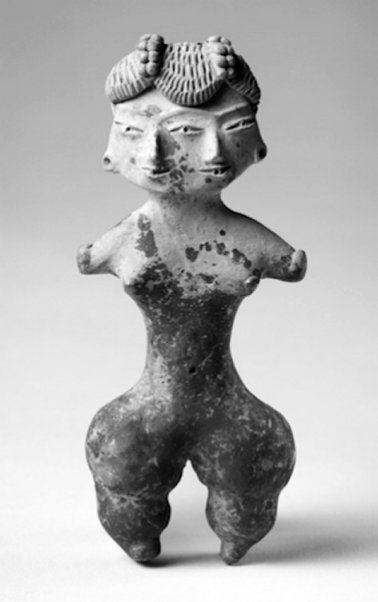 Tlatilco Two-headed FigurineShannon Dorey, Day of the Fish p. 137 |
This is a two headed figurine from the Tlatilco culture of Mexico dated 1200-900 BCE and located at Princeton University Art Museum. Notice the fat legs or steatopygia as it is known. I refer to this in Day of the Fish because so many ancient goddess figurines have these fat legs. I believe these legs are associated with the Nummo since they would have been useful for floating in an aquatic environment.Shannon Dorey, Day of the Fish p. 155 The Nummo were depicted in various ways but they were primarily aquatic beings.
Although they were hermaphrodites, the Nummo were symbolized by the sun, which was a female symbol. In her book, The Double Goddess, Vicki Noble reports that the Double Goddess represented female sovereignty in "most ancient cultures in the world before patriarchy."
She refers to various double goddess finds, and reveals that the two-headed Double Goddess from the Mexican Tlatilco culture is similar to some of the Old European figures from the ancient Balkans. Noble also refers to the work of Giti Thadani, who "relates that 'one of the earliest cosmogonies recorded in the Rig Veda is that of the dual feminine deities-Dyava ... referred to often as twins (jami) ... dual mothers ... in a feminine kinship genealogy with prithvi (Earth), and a generative chain of dual mothers.'"
Noble points out that many of the figures were found in so-called cult settings, such as temples or shrines, "strongly supporting the assumption that they represent deities, whereas others found in burials or refuse piles have elicited more disagreement over their titles."Shannon Dorey, Day of the Fish p. 138
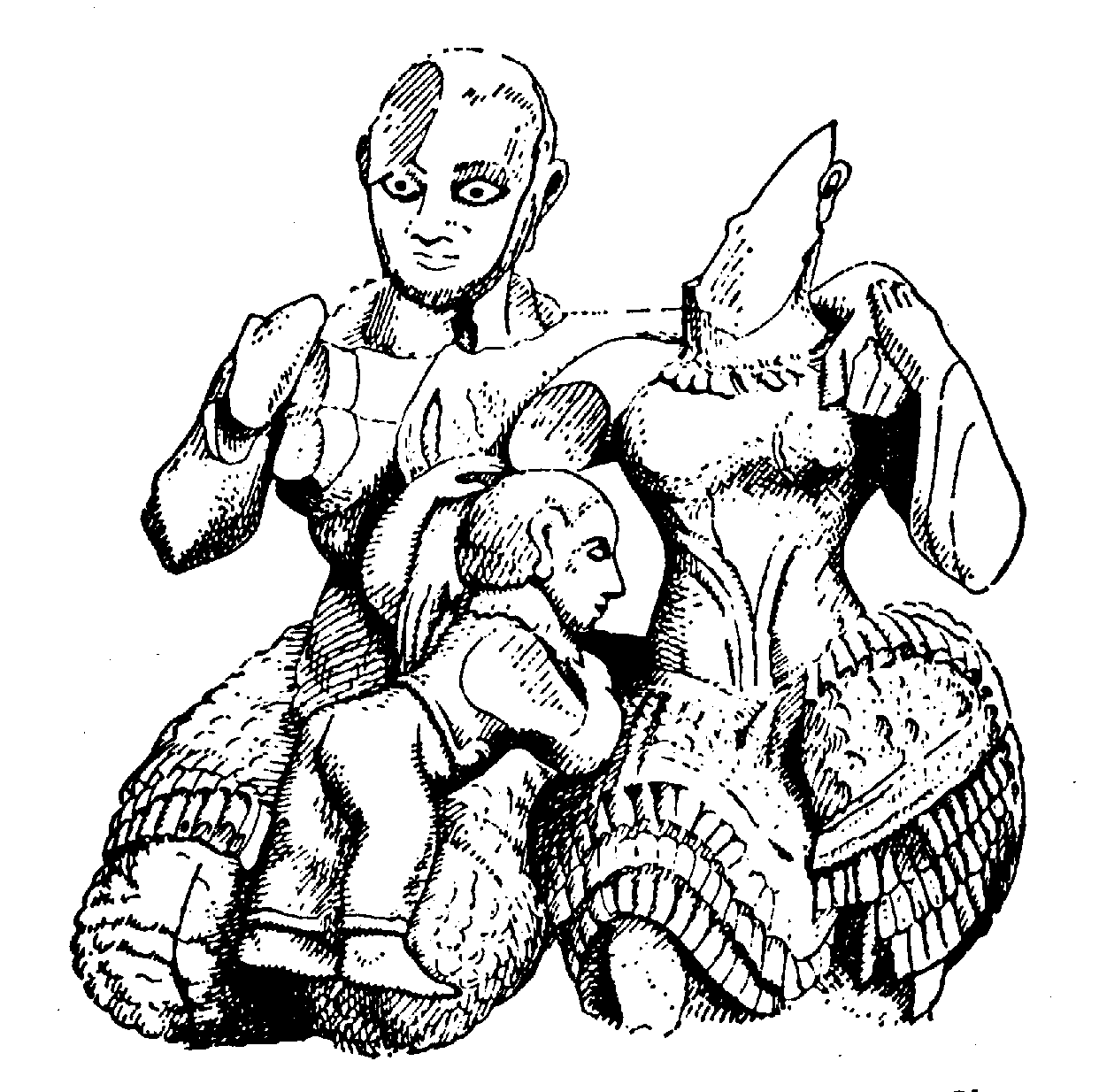 Two Queens With KingShannon Dorey, Day of the Fish p. 137 |
The twinness of the goddess is also found at Pylos on the Greek mainland, identified as the Mycenaean palace-city of King Nestor in the Iliad. Jospeh Campbell writes about the artefacts found there: "We learn of a divine triad called, 'the Two Queens and Poseidon'; further, of 'the Two Queens and the King.'… A number of terra-cotta figures are known which show two women joined together like Siamese twins and with a child seated on their common shoulder. These too have been interpreted as representations of the Twin Goddess with the Young God."Shannon Dorey, Day of the Fish p. 138
If we compare these figures to the Dogon religion, they represent the single-sexed male Jackal and his androgynous sister, the Mistress of Speech, who was part Nummo and part human and considered a twin. According to Campbell, "In the earliest recorded mythology of Sumer, the dead and resurrected god Dumuzi-absu, 'The Faithful Son of the Abyss' was in destiny involved with two mighty goddesses; or, better, one goddess in dual form. She was, on one hand, goddess of the living, and, on the other, goddess of the dead."
The Mistress of Speech's human part was mortal and her Nummo part immortal. In the Dogon religion immortality represented life, and mortality death. "John Chadwick identified the 'two mistresses and the king' as the precursor of the goddesses Demeter and Persephone, and the sea god Poseidon, who was often depicted on ancient artefacts with a fish-like serpent tail."Shannon Dorey, Day of the Fish pp. 137-138
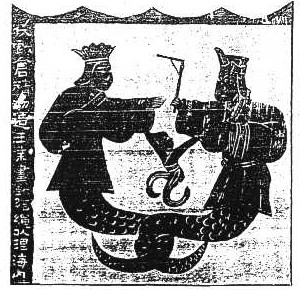 Nuwa and FuxiShannon Dorey, Day of the Fish p. 354 |
I believe similar representations appear in China in the figures of Fuxi and Nuwa.Shannon Dorey, Day of the Fish p. 127 In accordance with descriptions of the Nummo, these figures have serpent tails. The small serpent-tailed child is likely associated with the Jackal, who was considered the first human, and who had two serpent legs in comparison to the Nummo, who only had a serpent or fish tail.Shannon Dorey, Day of the Fish p. 128
In Chinese mythology, the goddess Nüwa was credited with creating humans. She and her husband, Fuxi, often called the parents of humankind, taught humans many things. Like the Mistress of Speech, Nüwa was often depicted with the upper body of a woman and the lower body of a snake or dragon. Playing a similar role to the Nummo, who cleaned up the Earth after the fire and flood had devastated it, the goddess and her husband carved out the rivers of the world and drained the floods.Shannon Dorey, Day of the Fish p. 128
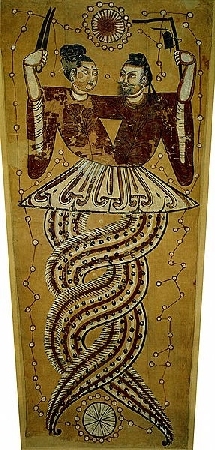 Nuwa and FuxiShannon Dorey, Day of the Fish p. 127 |
This painting of Nüwa and Fuxi, which is located at the Xinjiang Uighur Autonomous Region Museum, was unearthed in Xinjiang, China which has a documented history of at least 2,500 years. The interesting thing about this silk scroll, dating from the Early Tang Dynasty (651-676), is that both serpent figures wear one skirt and only one arm each is shown, suggesting that this is one androgynous being. Fuxi holds a set square in both images, which is a Masonic symbol.Shannon Dorey, Day of the Fish p. 112
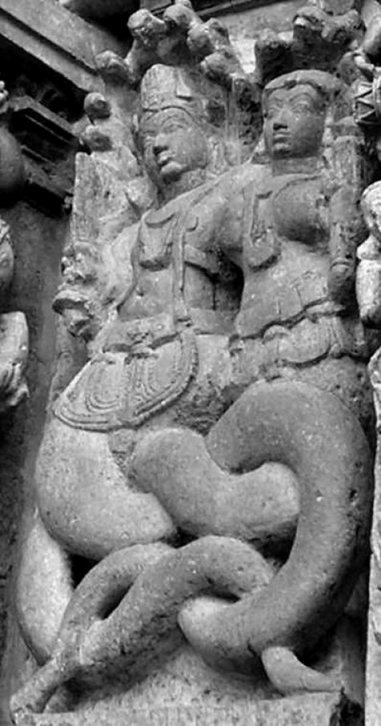 Nãga Couple IndiaShannon Dorey, Day of the Fishp. 250 |
The Nãga are deities or beings that take the form of a very great snake, and appear in Hinduism, Buddhism and Jainism. This Hoysala sculpture of a Nãga couple is found in the old city of Halebidu, the Hassan District, Karnataka, India. Halebidu was the 12th-13th century capital of the Hoysala empire. "Nãgas are believed to both live on Mount Meru, among the other minor deities, and in various parts of the human-inhabited earth. Some of them are water-dwellers, living in streams or the ocean; others are earth-dwellers, living in underground caverns." The Nummo also lived in water and underground caverns and caves.Shannon Dorey, Day of the Fish p. 251
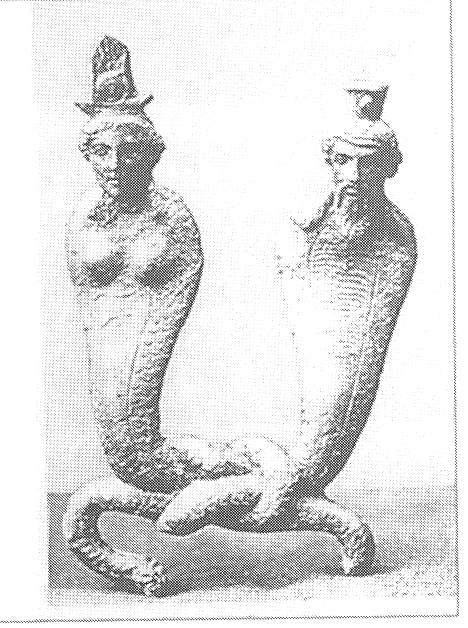 Isis and SerapisShannon Dorey, The Master (Mistress) of Speechp. 51 |
Greek depictions of the Egyptian goddess Isis likewise show her as a serpent. Here she is depicted with the god Serapis, which is similar to the image of Nüwa and Fuxi. The knotting of their tails may suggest that this is one androgynous being.
Serapis was the Greek name for a god that was partly Osiris and partly Apis, the sacred bull. The bull was a symbol of the Dogon Jackal. This statue was excavated at the Greek city of Cyzicus in ancient Phrygia. The worship of Isis and Serapis moved from Alexandria to areas throughout the Hellenistic world after the fourth century BCE.
Isis is considered to be an earlier form of the Egyptian goddess Neith. Katherine Griffis-Greenberg writes that Neith was an androgynous being often referred to in Egyptian texts as the "eldest," the "first" deity, and associated with the "cow of heaven." Cows were another symbol of the Nummo and in the Dogon language, the word cow, nã had the same etymology as sun, nay, and mother, na.Shannon Dorey, The Master (Mistress) of Speech pp. 50-51
In quoting the coronation speech of Nectanebo III, the last native Pharaoh of Egypt, Margaret Murray reports that the reason the temple of Neith had been so endowed was because "Neith was the mistress of the ocean, and it was she who bestowed its bounty." The Nummo and the first Nummo offspring were amphibians but spent most of their time in water.
According to Kenneth McLeish, Neith was identified with weaving. He speculates that this aspect derives from the ideogram of her name, Neit, which looks like a shuttle. In the Dogon religion, weaving was identified with the Mistress of Speech.
Griffis-Greenberg also quotes Ramadan el-Sayed, who hypothesizes that Neith "should be seen as a feminine doublet of Wepwawet, the ancient jackal-god of Upper Egypt, who was associated with both royalty in victory and as a psychopomp for the dead." Anubis, the jackal-god of ancient Egypt, was likely the same Jackal described by the Dogon elder Ogotemmêli.
Anubis was the "jackal-headed funerary god of Egypt before the rise of Osiris, the other great god of the dead." He was considered the chief deity to whom mortuary prayers were to be made and acted as the patron of embalming and guardian of the tomb. Ogotemmêli relates the Jackal to death. His roof dance prefigured funeral rites.Shannon Dorey, The Master (Mistress) of Speech p. 51
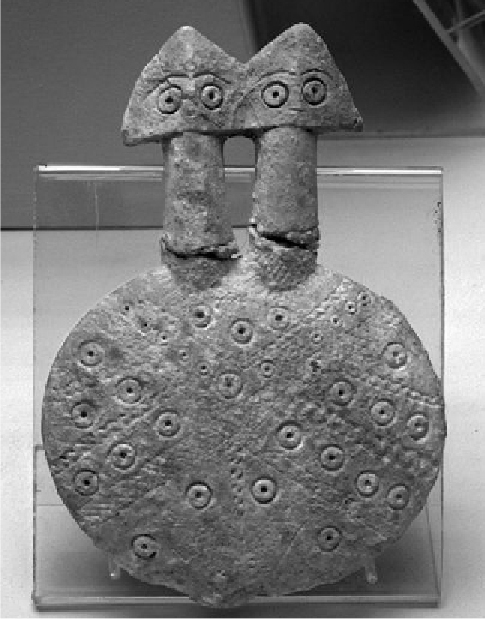 Twin Goddesses KultepeShannon Dorey, Day of the Fish p. 139 |
Strange discs featuring double headed goddesses with long necks like the Nummo were found in central Anatolia. The Nummo spaceship was described as a celestial form of the Nummo and identified with a round, red calabash, a symbol of the sun. This artefact is part of a larger group of flat marble goddess figurines found in Kultepe. It is especially important because it closely resembles two-headed mother goddess figurines of Alaca Hoyuk in Turkey.
Noble described a double disc goddess made of lead from Alaca Hoyuk, dated to around 2300 BCE that shows both female genitalia and a penis. Not only did the Nummo have long necks and were hermaphrodites but the ship's descent was associated with arrows.Shannon Dorey, Day of the Fish pp.139-140
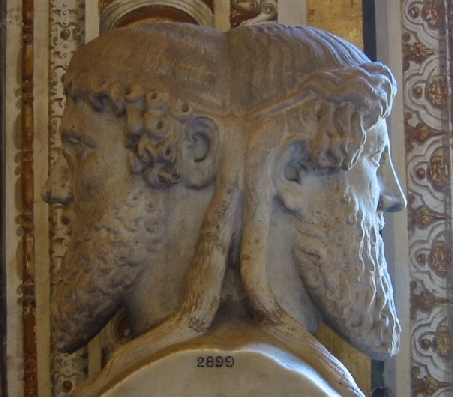 God of Doors Vatican CityShannon Dorey, Day of the Fish p. 133 |
The Dogon sculpture of the Nummo twins shown at the beginning of this article likewise reminds me of the Roman Janus, the double-headed god of doors. The Roman Janus is shown above as two males joined back to back.
Robert Graves believes that the God Janus borrowed his double-headed attribute from the goddess Carmenta who at the Roman Carmentalia, the Carmenta Festival in early January, was addressed by her celebrants as 'Postvorta and Antevorta: she who looks both back and forward.'
This would connect Carmenta with the sculpture of the Nummo twins, joined back to back one side male and the other side female. The sexuality of the female figure was likely later changed to the double-headed god of doors Janus, depicted as two males joined back to back, to accommodate the Roman culture which was male focused and patriarchal.Shannon Dorey, Day of the Fish pp.132-133
According to Graves when the goddess Carmenta was identified "as Cardea she ruled over the Celestial Hinge at the back of the North Wind around which, as Varro explains in his De Re Sustica, the mill-stone of the Universe revolves." The "Celestial Hinge" of the North Wind is suggestive of a door. Carmenta's identification with a celestial door hinge may be how the Roman god Janus became the god of doors. When the Nummo spaceship landed, it created a whirling wind and in The Nummo I associate it with Greek myths about Boreas, the North Wind, who was winged and had two faces and serpent-feet.
Boreas was also identified with Centaurus, who was an oracular hero with a serpent's tail, and the story of Boreas's mating with mares was attached to him.Shannon Dorey, The Nummo p. 81 In most descriptions of the Nummo, they had serpent or fish tails but in association with the Dogon smithy, they were depicted as Centaurs, identifying them with the male aspect of the Nummo, and associating them with the Greek Centaurus.Shannon Dorey, The Rose p. 53
Another name for Boreas was Ophion, the snake being who danced with Eurynomne, or Oreithyia, goddess of creation, and impregnated her. Graves identified Ophion with the serpent deity of Hebrew and Egyptian myths.Shannon Dorey, The Nummo p. 81
What these various images and myths indicate is that the alien Nummo were found in many places of the world substantiating my claim that the Dogon religion is the world's oldest religion.
For more information on the Dogon religion refer to my books, The Master (Mistress) of Speech, The Nummo, Day of the Fish and The Rose.